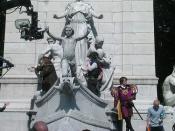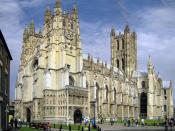During the 1600s, religious differences were a major issue in England. Citizens, called Puritans, wanted to see more reforms done to the Anglican Church, which was first established by King Henry VII. They thought that the church still had many of the Catholic customs they wished to be rid of. Bishops continued to exist in the Anglican Church though the Mass was abolished. Priests were still adorned in decorative robes for religious services and the parishioners still had to kneel down during services. Basically, they sought to "purify" England even more, thus their names. Their efforts to try and make changes to the Anglican Church greatly affected the reigns of Elizabeth I's successors: James I and his son, Charles I. It often influenced the monarch's policies.
When Elizabeth I died, she failed to produce an heir by never marrying. As a result, James VI of Scotland was put on the English throne as James I.
Like his predecessor, James was a passionate supporter of the Anglican Church. Because of this, he did not have much leniency for Puritan's demands for the improvement of the church. What little tolerance he had went to the agreement of a new translation of the Bible to English, called the King James Version or Authorized Version (one of the most commonly used English translations today). Other than that, James disapproved of further modifications to church doctrines. Upset by the king's refusal, many Puritans left England to flee to Holland and later sail on the Mayflower, heading for a new life in the Americas.
Unfortunately for James, many members of Parliament intensely stood for the Puritans. As a result, they often opposed several of James' policies. His reign had problems with increasing inflation and mounting government activity. The money he collected from taxes was never...


